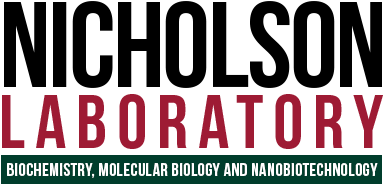Teaching
I teach at the undergraduate and the graduate levels, with a primary focus on molecular biology, biochemistry, and nanotechnology. My approach is to bring the excitement of new developments and new vistas in these fields to the classroom, while also providing essential foundational material. My laboratory also provides an environment for undergraduate and graduate students to undertake original research projects. Current course syllabi are posted here.
Honors Introduction to Biology II (Undergraduate)
Honors Introduction to Biology II (Biology 2912) provides an in-depth examination of the molecules and mechanisms of life on earth. Topics include chemical bonding, carbon chemistry and the structure and properties of water relevant to living systems. The constituents, structures, and functions of proteins, carbohydrates, nucleic acids and lipids are examined, as well as biological thermodynamics and enzyme kinetics. The course also addresses cell structure, mechanisms of cell-cell communication, intracellular signaling, the cell cycle and cell motility. Mechanisms of gene expression and regulation, and chromosome structure and replication are followed by an analysis of classic (Mendelian) genetics and molecular genetics. The course also examines virus structure and function, and provides a survey of genomic technologies and biotechnological tools.
Course Objectives
- Obtain fundamental knowledge of biological chemistry, cell biology, genetics, and molecular biology
- Provide a foundation for advanced courses in biochemistry, cell biology and genetics
General Biochemistry II (Undergraduate)
General Biochemistry II (BIO 4376) provides a comprehensive introduction to cellular biochemistry with a special focus on bioenergetics, metabolic pathways (catabolic and anabolic), metabolic regulation, and systems biology. This course requires a basic background in biochemistry and chemistry (through organic chemistry); a familiarity with basic mathematics (algebra) and introductory physical and inorganic chemistry.
Course Objectives:
- An understanding of the thermodynamics and energetics of biological systems
- An understanding of the synthesis and breakdown of biomolecules, including proteins, nucleic acids, lipids, and carbohydrates, and their importance to cellular function
- An understanding of the regulation and coordination of metabolic pathways
- An introduction to systems biology
- Connecting metabolic pathways to the physiological chemistry of organisms
- Connecting metabolic pathways to human health and disease, and disease treatment
Nucleic Acid Technologies
(Graduate)
(New course – offered Fall 2016)
The ability to detect, purify, characterize, synthesize, and sequence nucleic acids has transformed our ability to study the structures, functions and evolution of genes and genomes. The explosive expansion of big data involving genomic sequences reflects key advances in nucleic acid sequencing and sequence analysis technologies.
Nucleic Acid Technologies (BIO 5521) provides a focused analysis of the basic structures and properties of RNA and DNA and the enzymes that build or modify these molecules. The synthesis and purification of DNA and RNA will be examined, along with detection methodologies including enzymatic amplification, array analysis, and amplification-free (direct) approaches. Nucleic acid sequencing technologies, including sequencing-by-synthesis and nanopore-based approaches will be an additional focus. Finally, the course will address how the inherent ability of nucleic acids to self-assemble can be used to provide novel DNA and RNA nanostructures with biomedical and biotechnological applications.
Topics
- Nucleic acids (review): structures, properties, functions
- Enzymes of nucleic acid metabolism (polymerases, helicases, nucleases, inter alia)
- Nucleic Acid synthesis and purification technologies
- Nucleic acid detection methodologies
- Nucleic acid amplification: PCR and related methodologies
- Nucleic acid sequencing technologies
- Novel nucleic acids; and emerging nucleic acid nanotechnologies

